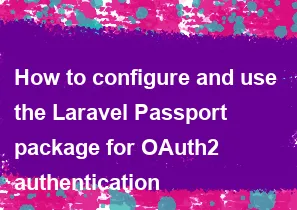How to configure and use the Laravel Passport package for OAuth2 authentication

Laravel Passport is a package that provides a full OAuth2 server implementation for your Laravel application. It makes it easy to set up OAuth2 authentication in your Laravel API. Below are the steps to configure and use Laravel Passport for OAuth2 authentication:
Step 1: Install Passport
To install Passport, run the following Composer command:
bashcomposer require laravel/passport
Step 2: Set up the Database
Run the migration command to create the necessary tables for Passport:
bashphp artisan migrate
Step 3: Install Passport
Next, install Passport using the passport:install Artisan command. This command will create the encryption keys needed to generate secure access tokens:
bashphp artisan passport:install
Step 4: Configure AuthServiceProvider
In your AuthServiceProvider (located at app/Providers/AuthServiceProvider.php), add the following lines to the boot method:
phpuse Laravel\Passport\Passport;
public function boot()
{
$this->registerPolicies(); Passport::routes();
}
Step 5: Update User Model
In your User model (usually located at app/User.php), implement the HasApiTokens trait:
phpuse Laravel\Passport\HasApiTokens;
class User extends Authenticatable
{
use HasApiTokens, Notifiable;
// ...
}
Step 6: Update auth configuration
In your config/auth.php file, make sure the api driver is set to passport:
php'guards' => [
'api' => [
'driver' => 'passport',
'provider' => 'users',
],
],
Step 7: Run your application
After completing the setup, run your Laravel application:
bashphp artisan serve
Step 8: Create API Routes
Now, you can define routes for handling OAuth2 authentication. Typically, this involves creating routes for login, registration, and accessing protected resources.
Step 9: Requesting Access Tokens
To obtain an access token, you need to send a POST request to the /oauth/token endpoint with the client credentials and user credentials.
Step 10: Protecting Routes
Use Passport's auth:api middleware to protect routes that require authentication. Apply the middleware to your API routes:
phpRoute::middleware('auth:api')->get('/user', function (Request $request) {
return $request->user();
});
That's it! You've now set up Laravel Passport for OAuth2 authentication in your Laravel application. Make sure to refer to the official Laravel Passport documentation for more detailed information and advanced configurations: Laravel Passport Documentation.
=== Happy Coding :)
-
Popular Post
- How to optimize for Google's About This Result feature for local businesses
- How to implement multi-language support in an Express.js application
- How to handle and optimize for changes in mobile search behavior
- How to handle CORS in a Node.js application
- How to use Vue.js with a UI framework (e.g., Vuetify, Element UI)
- How to configure Laravel Telescope for monitoring and profiling API requests
- How to create a command-line tool using the Commander.js library in Node.js
- How to implement code splitting in a React.js application
- How to use the AWS SDK for Node.js to interact with various AWS services
- How to use the Node.js Stream API for efficient data processing
- How to implement a cookie parser middleware in Node.js
- How to implement WebSockets for real-time communication in React
-
Latest Post
- How to implement a dynamic form with dynamic field styling based on user input in Next.js
- How to create a custom hook for handling user interactions with the browser's device motion in Next.js
- How to create a custom hook for handling user interactions with the browser's battery status in Next.js
- How to implement a dynamic form with dynamic field visibility based on user input in Next.js
- How to implement a dynamic form with real-time collaboration features in Next.js
- How to create a custom hook for handling user interactions with the browser's media devices in Next.js
- How to use the useSWRInfinite hook for paginating data with a custom loading indicator in Next.js
- How to create a custom hook for handling user interactions with the browser's network status in Next.js
- How to create a custom hook for handling user interactions with the browser's location in Next.js
- How to implement a dynamic form with multi-language support in Next.js
- How to create a custom hook for handling user interactions with the browser's ambient light sensor in Next.js
- How to use the useHover hook for creating interactive image zoom effects in Next.js